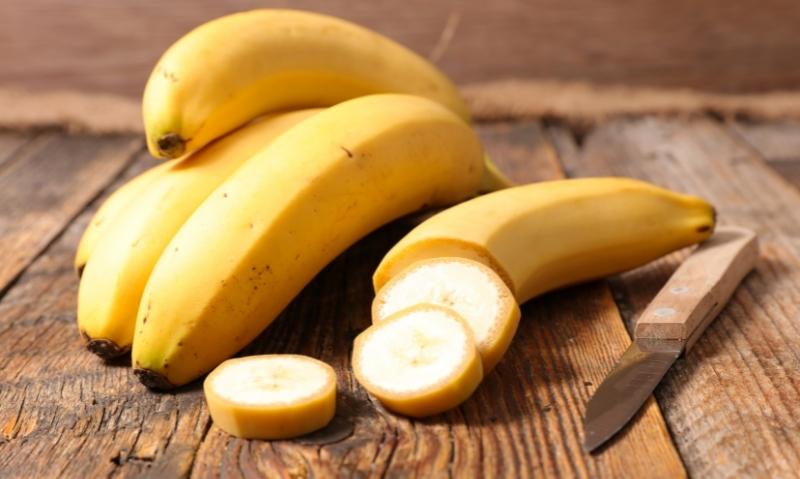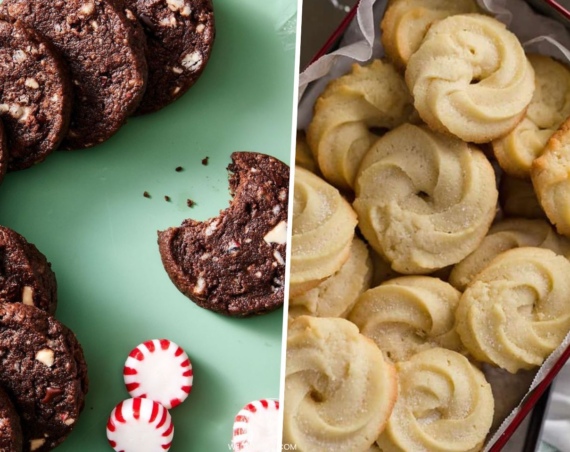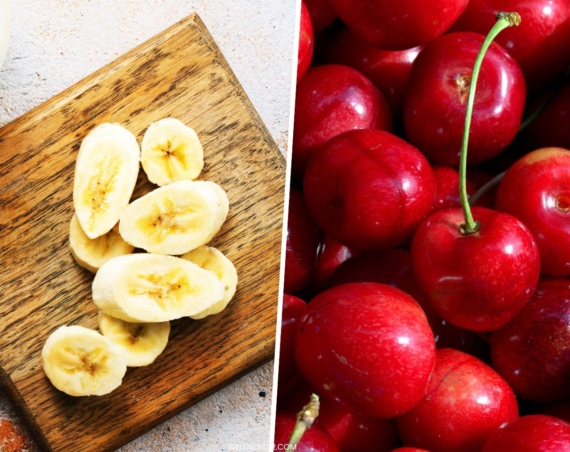
Are you wondering if your beloved bananas fit into your carb budget on a keto meal plan?
Known for their rich potassium content, there is no arguing that bananas are packed with nutrition, making them an ideal healthy snack for most people, especially children and athletes.
But, because over 90% of their calories come from carbohydrates, bananas do not fit easily into a carbohydrate-restricted diet, especially a keto diet.
It can be challenging to fit even one serving of fruit on a true keto diet, which severely restricts carbohydrates to 5% of calories or about 20 grams per day.
Just one medium banana, at about 25 grams of carbohydrates, already exceeds the 20-gram limit.
This rigid carb restriction should be considered just a temporary phase of a keto diet and not a long-term sustainable way of eating. Because of possible adverse effects, the beginning phase should be overseen by a doctor or dietitian.
The keto diet that most people follow for weight loss is known as a modified keto diet, which typically aims for less than 50 grams of net carbohydrates per day.
A small banana can fit into this version of a low-carb diet.
Nutrition Facts About Bananas
1 small (100 g) – 6-7 inches
- Calories – 90
- Total carbohydrate – 23 g
- Fiber – 2.5 g
- Net carbs – 20 g
1 large (136 g) – 8-9 inches
- Calories – 121
- Total carbohydrate – 31 g
- Fiber – 3.5 g
- Net carbs – 27 g
Are Bananas a Carb?
Bananas consist primarily of carbohydrates and water and therefore, yes they are considered a carb.
As mentioned above, over 90% of the calories in a banana come from carbs, which is why they are not considered keto-friendly.
The term “carbohydrate” can be misleading because not all carbs are created equal. Carbohydrates can be complex starches or fibers, and they can be simple sugars.
Your body processes these carbs differently. About 10% of the calories from carbs in a banana come from fiber.
Fiber has little to no caloric value in the body so these carbs can be subtracted from the total carbohydrates.
Fiber has the added benefit of stabilizing blood sugar levels by slowing down digestion. This is why it is important to calculate net carbs on a keto diet.
To calculate net carbs you simply subtract the grams of fiber from the total carbohydrate content.
Net Carbs In Banana
The amount of carbs depends on the size of the banana. After accounting for the fiber, a large banana nets approximately 27 grams of carbs, a medium-sized nets 24 grams, and a small-sized is about 20 grams of net carbohydrates.
If you cut bananas into 1-inch pieces and freeze them, each 1-inch piece is about 3 grams of net carbs. The ripeness of a banana affects how your body processes the carbs.
A green banana is higher in a type of carb called resistant starch.
This doesn’t mean there are fewer carbs, it just means that there is a higher content of resistant starch in a green banana. During the ripening process, the resistant starch in a green banana breaks down into simple sugars.
Because resistant starch is digested much slower in the body, it doesn’t cause a spike in blood sugar the way simple sugars, like glucose, do in a ripe banana.
For this reason, green bananas have a much lower glycemic index.
Will a Banana Kick Me Out of Ketosis?
Achieving and maintaining a state of ketosis is highly individualized.
This is why it is recommended that you work with a nutrition professional who can help you plan a keto diet that meets your nutritional needs, monitor, and evaluate your labs, and help you manage any side effects.
Once it is deemed safe for you to start a keto diet, a dietitian can help you figure out your goal carb intake, which takes into account your age, gender, metabolism, body composition, physical activity level, lifestyle, overall health, etc.
In the initial phase of a keto diet, where the goal is to maintain a state of ketosis, high-carb fruits will not be on your meal plan.
However, this highly restrictive phase is temporary, and as more carbohydrates are added to your diet in later phases, bananas in small amounts may be included.
On a final note, with regard to whether your body is maintaining a state of ketosis, the only way to really know is to measure ketone levels. Blood ketone levels are the most accurate measure of ketosis.
Health Benefits of Bananas
Bananas are one of the most popular fruits on earth and a favorite snack across the lifespan from infants to the elderly.
They are loaded with nutrients including fiber, vitamins, minerals, and antioxidants.
They are exceptionally rich in potassium, vitamin c, manganese, and vitamin B6. In fact, a medium banana contains 20% of the daily value (DV) for vitamin B6.
They are also a good source of magnesium and folate.
Bananas contain resistant starch, which acts as a prebiotic in the body and has favorable effects on blood sugar. The greener the banana, the greater the amount of resistant starch.
How to Eat Banana on a Low-Carb Diet
The answer to this question is highly individualized. A small banana provides 20 grams of net carbs.
If your goal is to eat less than 50 grams of net carbs per day, then you could fit a small banana into your meal plan, but it will fill up a good chunk of your carb allowance. Again this is not a one size fits all diet.
A highly active individual who is following a low-carb diet is going to have more flexibility with carbs.
For example, small banana with peanut butter is an excellent way to replenish and nourish the body after intense exercise.
For someone who is just beginning the most restrictive phase of a keto diet, it is best to stick with keto-friendly fruits.
A dietitian will take into account your history, body composition, age, activity, and exercise level to determine an appropriate carb count for you and help you plan meals and snacks.
Creative Ways to Include Banana In a Low-Carb Diet
Tip #1
Cut 1/2 into thin slices and top on cottage cheese or full-fat Greek yogurt. Give the other half to a family member or freeze it for later.
1/2 of a small banana contains 10 grams of net carbs. Top this delicious bowl with toasted almonds or sunflower seeds.
Other great toppings or mix-in options include stevia sweetener, vanilla extract, coconut flour or flakes, almond flour, chopped nuts (walnut, pecans), and cinnamon.
This simple recipe is not only keto, but it also fits into other diets as well, such as gluten-free, paleo, and diabetic.
Tip #2
Cut into 1-inch pieces, store in an airtight container, and place in the freezer. Throw 3 frozen pieces into your blender as part of a low-carb smoothie.
This adds natural sweetness to the smoothie while adding important nutrients like potassium, B vitamins, and fiber.
Three 1-inch pieces provide approximately 10 grams of net carbs.
Freezing small portion sizes is one of the best ways to eat higher-sugar fruits in moderation.
There are many other frozen fruit options you can use, such as frozen açaí puree (unsweetened), blueberries, or raspberries.
Adding avocado is an excellent way to give your smoothie a creamy texture.
Substitutes for Bananas On Keto
In baking, there are some lower-carb options you can use in place of bananas, such as mashed avocado or canned pumpkin.
Chia seeds are another great option to use in place of high-sugar fruits in recipes. Transform chia seeds into a gel-like consistency by combining 1 tablespoon of chia seeds with 3 tablespoons of water, and let soak for 5-10 minutes.
Many keto-friendly recipes use this substitution to replace higher-carb fruits in low-carb baking.
How to Add Banana Flavor Without Adding Grams of Sugar
You can use pure banana extract if you’re craving a banana flavor without the added sugar from an actual banana.
Make sure to look for an extract made from real bananas, not imitation flavors or artificial flavorings.
There are many ways you can use the banana extract as a flavoring: add it to low-carb smoothies, ice cream, bread, pancakes, waffles, or French toast.
Try adding a few drops into sugar-free syrup or into the batter of your favorite dessert recipes, such as low-carb banana bread, cookies, banana pudding, or keto banana muffins. A little bit goes a long way so start by adding just a few drops.
A quick google search or Pinterest search will yield many excellent keto dessert recipes that use natural banana extract.
Recipes for keto banana bread or banana muffins commonly use the following ingredients so be sure to keep them stocked in your pantry or refrigerator:
- almond flour
- coconut flour
- baking powder
- coconut oil
- a granulated sweetener like erythritol
- butter
- eggs
- banana extract
- vanilla extract
- cinnamon
- walnuts.
Some recipes use unsweetened almond milk, cream cheese or Greek yogurt.
Try experimenting with different banana muffins or keto banana bread recipes and pick your favorite!
What Are Some Keto-Friendly Fruits?
Fruits lowest in net carbs per serving are:
- açaí berries
- avocados
- lemons
- limes
- olives
- coconut meat
- tomatoes
- star fruit
- blackberries
- plums
- raspberries
- strawberries
- watermelon
Keep in mind that some of these fruits are only keto-friendly if you stick to the recommended portion size.
1 cup of watermelon nets 10 grams of carbs, however, it’s easy to quickly exceed a 1-cup portion size.
What Is the Lowest Carb Fruit?
After accounting for fiber, açaí berries (unsweetened) are the lowest carb fruit with 1 gram of net carbs per serving (100 grams).
Last Words
Sometimes bananas are labeled as bad or forbidden because of their higher carb content.
This tends to happen during a popular diet trend, where certain foods or macronutrients (macros) become labeled as bad.
For many years, high-fat foods were considered bad — like eggs, butter, coconut, and full-fat Greek yogurt.
Now, most people understand that these are highly nutritious foods and that the fat content actually helps to create a sense of fullness and satisfaction.
In a complete reversal of the “fat is bad” mentality, the keto diet has fueled the fire of the “carbs are bad” mentality.
Foods that don’t fit the typical keto profile (high-fat, low-carb, and moderate in protein) get tossed into the “bad” foods category. This happens to bananas because they are high in carbs. This doesn’t mean that they’re unhealthy though.
It simply means that in order to stay within a certain carb budget, high-carb fruits may need to be replaced with low-carb fruits.
Please note that certain groups of people are advised not to follow a ketogenic diet, including people with: type 1 diabetes, pancreatic disease, liver conditions, thyroid problems, eating disorders, gallbladder disease, pregnant or breastfeeding women, and athletes.
Always check with your doctor or dietitian to first make sure it is safe for you to start a keto diet.


